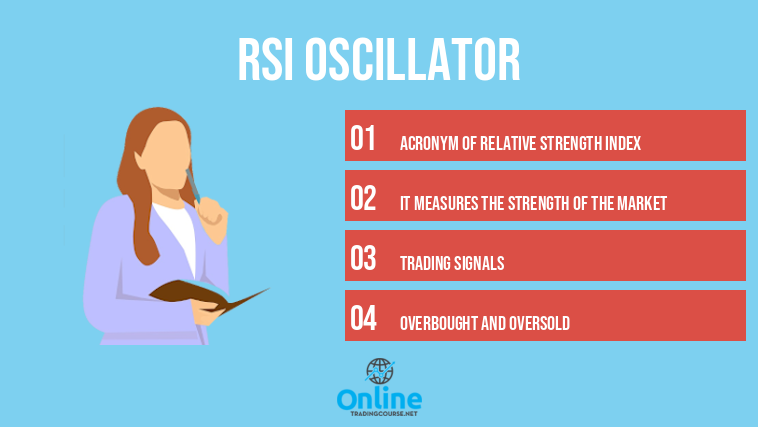
RSI Oscillator
Have you already heard of the RSI Oscillator? If you are here probably yes. After all, it is one of the best trading indicators out there, used by all the top professionals in the world of financing, but often also by beginners.
The RSI, also known by the full name of “Relative Strength Index, is an indicator used to measure the strength of the market. Alone, or alongside other trading indicators, it is able to offer excellent trading signals whenever they appear on the chart.
In our guide and in-depth analysis on RSI, you can find out what are the recommended parameters for its profitable use. We will also explain how you can obtain all the useful information from the indicator, for a reliable and objective market analysis.
So keep reading our guide, with the help of the RSI oscillator you can bring rationality and precision to your negotiations on the financial markets. By learning all the tricks and secrets related to the oscillator, you can improve your trading performance and therefore also your profits.
No other trading indicator is able to verify the strength of the current trend as the Relative Strength Index does. You can use it right away to trade on any market available on the best trading platforms.
If you want to start trading right away, keep in mind that you also have the possibility to copy, in a completely automatic way, what the best traders in the world do.
How? Thanks to the eToro platform that allows you to easily identify the traders who, in the past, have obtained the maximum profit with the minimum risk and, with this automated trading tool, to copy them completely automatically.
With eToro, beginners can get the same results of the professional traders starting from day one, in addition, they can learn from them.
You can sign up for FREE on eToro by clicking hereIndex
What is RSI Oscillator and how it works?
Among the trading oscillators, the RSI is one of the most appreciated ones so far. It has always been used to make profitable transactions, especially on the Futures market (i.e. the commodities market), but there are many traders who prefer it for Forex and stocks.
The “Relative Strength Index” is a very dated indicator, its invention dates back to 1978. In that year Welles Wilder, the inventor of the RSI, patented it by publishing the book “New Concepts in Technical Trading System”. Despite the fact that the indicator is old, it is more effective than ever in market analysis.

In the image you can see a classic price chart: at the top there is the representation of the price (in the form of Japanese candles); below, we find the RSI represented by this blue line that precisely “oscillates” within a very specific range.
What are “oscillators”?
To understand exactly what RSI is and how it works, it is first necessary to specify that it is an oscillator.
In online trading there are two types of indicators that can be divided as follows:
- Oscillators: so called trading indicators that are not displayed directly on the price, but have their own specific graph. They take this name from the fact that they move within predefined ranges or oscillate around a line.
- Indicators: the difference with oscillators is that an indicator is positioned directly on the price and follows its trend. Many indicators, such as supports and resistances, are traced by traders by hand directly on the chart. But the same goes for Trend Lines too.
The RSI is therefore part of the large oscillator family. This kind of analysis tool is very effective for trading and gives its best in the market side phases called “Trading Ranges”.
Why use RSI Oscillator?
Any oscillator, including the RSI, is used for the purpose of analyzing and measuring market trends. Thanks to the RSI, a trend can be confirmed and validated in its strength, or the indicator can ring the alarm bell indicating that there are indications of a trend reversal.
Oscillators offer 2 main readings on the markets:
- Indicate high levels of overbought and oversold
- Indicate divergences
When so-called “extreme” areas are reached within the oscillators, fundamental data are obtained to perform good trading operations.
For example, when indications are obtained with the oscillators on the strength or excess in the price trend, market signals can be generated. The extreme areas are usually indicated with the terms of “overbought” and “oversold”.
When the oscillators reach these extreme areas, the trader must be careful to evaluate the situation. At the moment of escaping from these turbulences, valuable trading signals are generated because they increase the probability of a trade’s success.
Read also: Bollinger Bands
Range and Values of the RSI Oscillator
On the best online trading platforms you will find all the most important indicators and oscillators, among which RSI can never be missing. To make it appear below the price chart of the selected asset, just scroll the menu of indicators (every good platform should have one).
Once the oscillator has been selected, in general, you will set its calculation settings; a good rule of thumb, especially if you are a beginner, is to leave the default values unchanged. Unless special cases, the standard values set on the platform are very efficient for analyzing the performance of any good market title.
Usually, the standard value that can be found on any platform is 14 periods. If you want, you can change it, but we advise you not to do it, for the simple fact that increasing or decreasing this value can cause the generation of false market signals.
In general, we can say that traders tend to lower the number of periods from 14 to 9 or 7 to make the indicator more agile and faster when operating on the Time Frame of the narrower graphs, below the day trading perspectives.
As we said, the RSI is already ready for use on the trading platforms, however, we report here the formula for its calculation for completeness:
- RSI = 100 / (1 + R)
The oscillator moves within a range of values from 0 to 100. Which values should you pay particular attention during the phase of negotiation?
Overbought and Oversold Areas
The key moments that must never go unnoticed by a trader occur when the oscillator moves to its outermost areas:
- Sign of excessive fall: below the value of 30, the market shows an excessive fall. This is an example of the extreme negative of the market.
- Sign of excessive rise: in the same way, it is necessary to observe the area above the value of 70. This is an example of extreme positive of the market.
In the first case, this is a situation where the asset has moved too strongly and too quickly to the downside. Consequently, the oscillator must be considered oversold.
In the second case, the situation is the opposite. Prices have been pushed too high and too fast, which is why the market may soon seek new levels of balance. We are in an overbought phase.

In the image above, you can see 2 consecutive market examples that move in excess phases. The analysis in question uses the RSI to understand the market trend of the Forex Euro / dollar asset.
What we can observe is a daily chart of the euro dollar. Trading on that day started off strongly, pushing the price very high and bringing it to exceed 1.30. However, the market ended in excess and the RSI promptly reported the situation by highlighting values above 70 (first green circle).
Shortly after, it happened the opposite way. At around 1pm, the price suffered an excessive drop to 1.29, but the market, instead of continuing in the bearish phase, pushed to return to its equilibrium level of 1.30. The RSI was however ready to show the oversold with his line that has fallen below 30.
RSI and the median range
When the price is in the middle range, how can the situation be interpreted? When the RSI is around the value of 50, we are in a phase of substantial stability in the market price.
In such situation, however, the prevailing direction of the market can be identified. Just look at the behavior of the RSI line:
- We are in a tendentially bullish phase if the indicator curve is above the fixed median line
- We are in a more bearish phase if the RSI curve tends to move below the fixed midline.
Now it will probably be easier for you to understand where the indicator takes its name from. Thanks to the RSI, in fact, it is possible to perceive the relative strength of the market. It better defines the situations of stability and laterality of the market by showing the prevailing intentions of supply and demand.
This is why experts generally advise the use of RSI in the lateral phases of negotiations instead of those that have clear trends. With such a tool, even normally adverse trading conditions become favorable.
RSI Trading Signals
How can you use the indicator when trading on the financial markets? Based on market conditions, both bullish and bearish operating signals can be obtained:
1 – Long position opening signal
Going “Long” in jargon means buying the chosen asset or market title. But how do you understand the ideal time for a purchase?
It is not difficult to recognize it, every time the RSI falls below the value of 30, a clear bullish signal is obtained. The bearish trend of the market is not going to last and the price will soon rise again.

The perfect description of a purchase signal can be found in the image above. The exchange rate price on the Australian and Canadian dollar has been lingering for some time on the $ 0.94 share.
The RSI oscillator touches the share of 30 several times and exceeds it downward. Here is generated the bullish signal. The market confirms the new trend with a short upward trend that can be easily exploited with a purchase on the market.
The signal in this case is also confirmed by the breakdown of a resistance by the price, therefore it can be considered reliable.
2 – Short position opening signal
Going “Short” in jargon means opening a sales position on the market. Here’s how to find the perfect time to open such a position:
Every time the RSI goes above 70, it could generate a clear bearish signal. It is clear that there has been too strong a rise in the market, so the price will seek a new level of balance lower.

This image shows how there has been both a bearish and bullish signal in the same trading week. The graph we see is that of the Euro / Swiss franc Forex exchange. The overbought situation occurs at an altitude of 1.217 with RSI above the value of 70.
The market immediately reacted by starting a bearish trend that only stopped around the 1.214 level. Here again comes a signal from the RSI which, having gone oversold, signals the imminent subsequent rise to 1.2155.
RSI Oscillator and Market Divergences
Like any other oscillator, the RSI is also able to show the so-called “divergences”. The situations of divergence between the indicator and the price are essential in the context of market analysis. Signs of divergence are a huge advantage for traders because they allow you to capture market reversals just before they occur.
A divergence between the price of the currency and the RSI indicator can have two meanings:
- The price is running out, so there is likely to be a corrective move in the context of an existing underlying trend
- The end of the current trend is near and the market may reverse or being consolidate
But how do you spot a divergence? They occur when the price moves in one direction while the RSI moves in the other.
Divergences, therefore, can be of two types: bullish and bearish.
- Bullish Divergence: in such a situation, price movements can be observed. We see lower and lower lows, while the oscillator marks higher lows than the previous ones.
- Bearish Divergences: here instead the price shows higher and higher peaks while the oscillator sets and signs lower peaks than the previous ones.
Analysts understood the value of the divergences because they noted that especially in the long run they tend to be satisfied.
This means that if the RSI shows a bullish divergence, while the market is bearish, a bullish reversal of the trend could also occur soon. Similarly, if the RSI shows a bearish divergence in a short time, the negative market trend could also be undertaken by the price.
Risks of RSI divergences
The divergences, however, cannot be considered reliable in 100% of cases. First of all, they are not formed every time an inversion occurs, and vice versa, not always when the indicator shows them then the expected inversion occurs.
However, it is possible to say that, in the presence of a divergence, the chances of the trend reversing its run increase considerably. The big advantage, of course, is that the divergences allow to anticipate the market. But this is not always the right thing to do.
Moving ahead may risk exposing the investor to heavy capital losses. Therefore, caution should be exercised, because they do not suggest the precise moment when the trend reversal will occur.
Most professional traders await confirmation of the signal obtained by the RSI thanks to the use of other indicators. A great way to obtain confirmation of divergence signals is to use Trend Lines or Support and Resistances.
RSI Oscillator for Forex investments
To complete the picture relating to the RSI oscillator, we must certainly offer some advice on the best markets where to use it for trading online.
As you saw, the signals generated by the RSI come mainly from market excesses. This means that a particularly favorable analysis environment for the indicator are markets with high or very high volatility. The best example is the Forex market.
Forex or FX is the market where currency pairs are traded. As you may have noticed, during our guide we mainly chose images related to price charts of the Forex market, this was not a coincidence.
Forex very often presents the ideal conditions for trading through the RSI. This market is characterized by a high rate of volatility and this often means excesses such overbought and oversold areas.
In particular, we can advise you to operate on currency exchanges such as:
- EUR / USD
- USD / CAD
- JPY / NZD
- USD / JPY
- GBP /USD
How to (really) learn trading online
We already pointed out at the beginning go the article that beginner traders have the opportunity to copy (automatically) the best professionals thanks to eToro
You can also learn how to trade online thanks to the didactic support offered by Trade.com platform.
Many are looking for trading courses, but Trade.com offers much more: a complete coaching service, a professional who explains everything you need to know about trading with phone support and guides you step by step.
For services of this type, usually, you pay hundreds of euros per hour: with Trade.com this is completely free.
You can sign up for free on Trade.com by clicking here
Financial management advice
During the trading phase, needless to deny it, there are always risks. Markets are volatile and are often very difficult to interpret, for this reason you must learn to protect yourself and your trading capital.
Using a trading indicator such as RSI Oscillator helps you to predict market phases and possible reversals, but unfortunately this is not enough. Even if you work with the utmost caution, you can run into false signals that sometimes invalidate even the best analyzes.
In order to prevent false signals from affecting your trading capital, you must set the Stop orders on your trading platform in the best possible way. A good rule of thumb used by all professionals is to set a Stop Loss on the 5% maximum loss of your total capital.
This mechanism allows you to enter the market with all your trading potential, but to ensure an automatic exit from the trade in case the market begins to seriously move in the opposite direction to your open position.
With this simple precaution you can avoid hurting yourself in the negotiation phase and you can protect present and future investments.
In technical analysis, RSI stands for Relative Strength Index.
It serves to measure the strength of an ongoing Trend through overbought or oversold areas.
Levels 70 to 100 indicate an overbought area. Conversely, a level between 0 and 30 indicates an oversold zone.
By now all the best brokers offer this indicator for their customers, in particular the Metatrader already includes it by default within the analysis tools.
